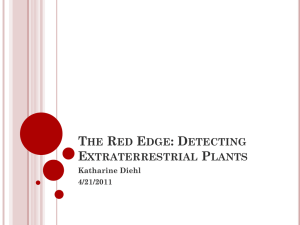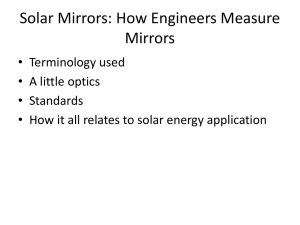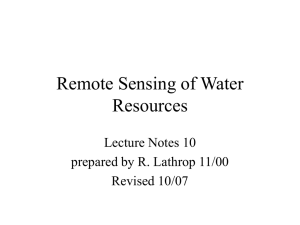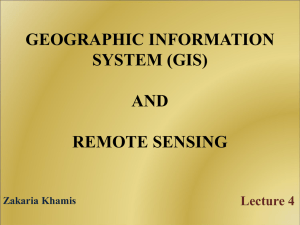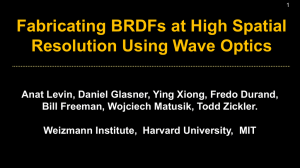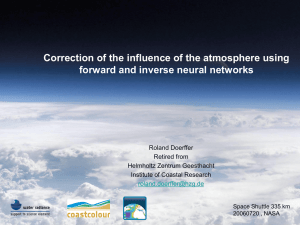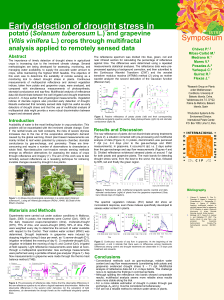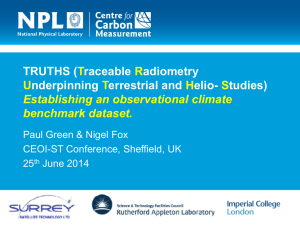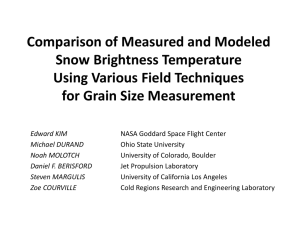2011_7_24-LLeigh
advertisement
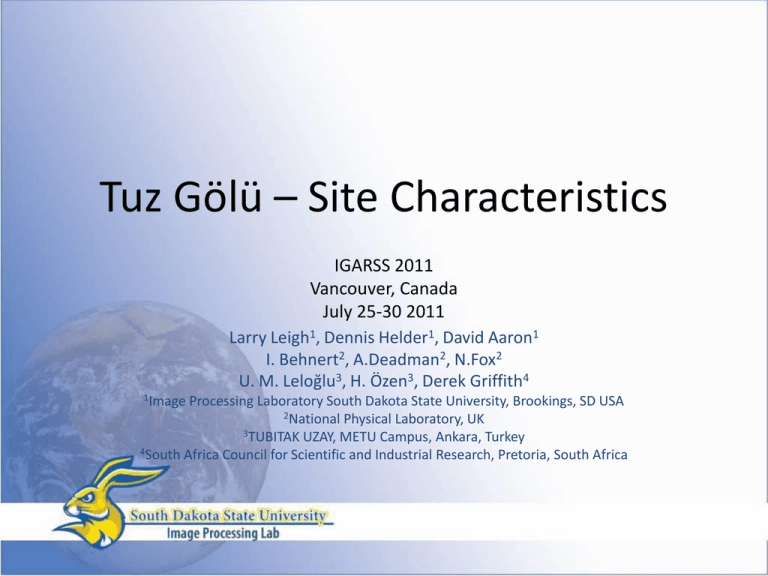
Tuz Gölü – Site Characteristics IGARSS 2011 Vancouver, Canada July 25-30 2011 Larry Leigh1, Dennis Helder1, David Aaron1 I. Behnert2, A.Deadman2, N.Fox2 U. M. Leloğlu3, H. Özen3, Derek Griffith4 1Image Processing Laboratory South Dakota State University, Brookings, SD USA 2National Physical Laboratory, UK 3TUBITAK UZAY, METU Campus, Ankara, Turkey 4South Africa Council for Scientific and Industrial Research, Pretoria, South Africa Outline • Tuz Gölü Campaign Overview • Tuz Gölü Spectral Reflectance Study • Bi-directional Reflectance Distribution Function (BRDF) Analysis • Atmospheric AOT Stability • Conclusions Tuz Gölü Campaign Overview • CEOS field campaign which took place Aug 13 – 23, 2010 • Consisted of 13 different teams from across the planet. • Primary goals, – Evaluate differences in field instrument primary calibrations – Evaluate differences in methods for characterizing and assigning “radiometric value” to a site, for multiple view angles – Establish formal traceability of Tuz Gölü reference site based on an evaluation of all comparison results. – Establish “best practice” guidance for above and/or knowledge of variance between methodologies. – Provide a multi-satellite sensor comparison linked to the ground calibration derived from the multi-team comparison. – Identify the minimum and ideal specifications for characterization/instrumentation for a CEOS “reference standard” Tuz Gölü Campaign Overview • Located in central Turkey. – 1 hour north of Aksaray, about 2 hours south of Ankara. – Salt flat at an elevation of about 3000 ft. – Covering an area of 14 miles wide x 22 miles long – Covered with water for most of the year. – Bright in the short wavelengths. Tuz Gölü Spectral Reflectance Study • Primary Goal was to develop a comprehensive understanding of: – – – – best practices for surface measurements uncertainties associated surface measurements The absolute ground level spectral reflectance of the site The variability in reflectance both spatially and temporally • The site measurement phase of the study commenced with identifying, marking, and subsequently measuring a series of subsites on the Tuz Golu salt flat. These sub-sites were identified as: – M1 mini-strip – M1 test site – M1-M9 test sites - for temporal analysis - for small scale variability - for larger scale variability • A more detailed description of the sub-sites and studies follows. Tuz Gölü Spectral Reflectance Study: Short Term Stability Study: M1 min-strip • To characterize short term temporal site stability and measurement uncertainty the small “M1 mini-strip” was used. – To reduce illumination angle differences and BRDF effects, acquisition of the M1 mini-strip data was restricted to 10:4510:50am – The collection of data was confined to a precise 30 meter by 5 meter location. • 30 spectra “in motion” were taken down the center of the strip • This site was knowingly selected to be “pristine” – Maximal uniformity – Minimal degradation from traffic – Minimal “blemishes” Tuz Gölü Spectral Reflectance Study: Short Term Stability Study : M1 mini-strip • Reflectance from 9 days of collection over M1 mini-strip show very good repeatability – For short wavelengths reflectance varies from 0.40 – 0.60. – For longer wavelengths reflectance drops off to 0.05 – 0.15 Tuz Gölü Spectral Reflectance Study: Short Term Stability Study : M1 mini-strip • Reflectance variability for ‘limited location, limited time’ study is on the order of 0.01 reflectance units. – 8 days of consecutive data is shown – Black lines represent absolute standard deviation • +/- 0.01 in reflectance Tuz Gölü Spectral Reflectance Study: Medium Resolution Stability Study : M1 • To investigate the larger spatial stability of a moderate resolution sized calibration site. – The M1 site was selected. • Visually appeared relatively uniform and free from ash • Area walked by SDSU team each day • Collected data daily; however, time was either 10:50 – 11:20 or 11:30 – 12:00 • Data acquired “in motion” along the same transects each day – 100 spectra per transect were acquired (400 total) Tuz Gölü Spectral Reflectance Study: Medium Resolution Stability Study : M1 • M1 has a reflectance different than the M1 mini-strip – The change is on the order of 0.02 reflectance, in the VNIR • Standard deviation of M1 data, is similar to the M1 mini-strip Tuz Gölü Spectral Reflectance Study: Larger Resolution Stability Study : Full Site To evaluate spatial variation over a large region: Data was collected from all M sites, excluding M7 • Collected Data each day from M1 and one other site – First site: 10:50 – 11:20, Second Site: 11:30 – 12:00 • Took data along 4 transects spaced equally North/South – 100 spectra per transects were acquired » 400 total spectra per site Tuz Gölü Spectral Reflectance Study: Larger Resolution Stability Study : Full Site • Differences in reflectance are noted, some sites appear to have fewer “dark spots” and those better represented the reflectance seen on the “clean” M1 mini-strip. – Standard Deviation in the visible shifted closer to the 0.02 reflectance level for shorter wavelengths Tuz Gölü Spectral Reflectance Study If we look at the variation in terms of Landsat 7 bands. Reflectance M1 mini-Strip 9 day Ave Reflectance M1 mini- Strip 9 day STD Reflectance M1 Site 9 Day Ave Diff From Strip M1 Site 9 Day STD Reflectance Combined All M site Ave Diff From Strip Combined All M Site STD Band 1 49.1% 0.62% 46.8% 2.3% 0.55% 47.7% 1.4% 1.31% Band 2 55.0% 0.50% 52.4% 2.6% 0.47% 53.5% 1.5% 1.49% Band 3 60.6% 0.48% 57.9% 2.7% 0.43% 59.1% 1.5% 1.72% Band 4 58.5% 0.42% 55.7% 2.8% 0.39% 56.7% 1.8% 1.44% Band 5 13.4% 0.75% 13.0% 0.4% 0.52% 12.9% 0.5% 0.74% Band 7 7.5% 0.45% 7.5% 0.0% 0.32% 7.4% 0.1% 0.42% • Overall uniformity is very encouraging, Spatial uncertainties for large areas is less than 1.75%. • Sampling strategy needs consideration, but errors in accuracy levels of less than 2% can be easily achievable These errors would be carried through to vicarious calibration results BRDF Analysis • Evaluation of the BRDF for the site is an important step in site characterization; a study of how the site’s apparent reflectance changes based on view and illumination angles was initiated. • Site measurements were made with the Gonio RAdiometric Spectrometer System (GRASS)* – Spectral coverage from 400 to 1700 nm – Angles of measurements: 0, 90, & 180 azimuth, and 10, 20, 30, 40 and 50 degree zenith view angles. – Two separate locations on the salt flat were used * Work performed by Andrew Deadman from National Physics Lab, UK BRDF Analysis • Preliminary analysis shows a significant BRDF for the site, as much as a 0.20 reflectance change for 10 degrees variation in view angle. – More investigation is needed to determine the full BRDF of the site Atmospheric Stability. • Since these types of sites are used to calibrate space and airborne sensors, it’s important that both the surface and the atmosphere is understood, and ideally very stable. – To evaluate the atmospheric stability of the site, two instruments were used. • TUBITAK UZAY deployed a CIMEL • SDSU deployed a Shadowband – These instruments are both used to evaluated the aerosol and water vapor loading of the atmosphere. Atmospheric Stability. • Ideally we would like to see low AOT numbers < ~0.2, along with low day to day variability. – This site had both high optical thickness, and high day to day variability, which makes long term modeling of the site impossible. – Issues can be overcome but require good on location measurements • Atmospheric Stability. Short term (< 30 minutes) stability is low – Changes in AOT of .05 cause as much as 0.04 change in short wavelength transmittance values for the atmosphere – Directly impacts vicarious calibration accuracies – Implies a non-homogeneous atmosphere • Care needs to be taken to select more stable days Conclusion: Reflectance • Tuz Gölü is highly reflective in the VNIR, but dark in the SWIR • Under “Pristine” conditions Tuz Golu surface reflectance measurements can be repeatable / reproducible to 0.005-0.01 reflectance units • Absolute surface reflectance values can change spatially by 0.02-0.03 units over short distances • Initial BRDF measurements imply a strong dependency on angle, – as much as 0.20 reflectance for 10 degrees of change in reflectance – this needs to be studied in depth Conclusion: Atmospheric • Atmosphere AOT is observed to change from 0.35 to 0.15 – This reduces the best case transmittance of the atmosphere from 0.74 to 0.50 for these shorter wavelengths • AOT changes on a 30 minute scale were also noted: – 4% change in overall atmospheric transmittance. – These changes propagate into errors of the same magnitude in absolute calibration work Conclusion • Tuz Gölü site clearly has strong potential for satellite calibration work – High reflectance at shorter wavelengths, darker in NIR and longer wavelengths – Appropriate spatial and temporal stability for vicarious campaigns; difficult for use as an unmonitored, long-term site. – Accessibility limited to summer months – Atmospheric monitoring necessary As more and more campaigns are done at this location these issues will become better understood, and resolved.
